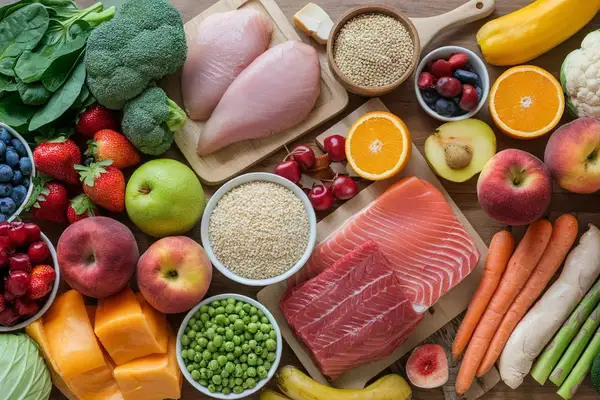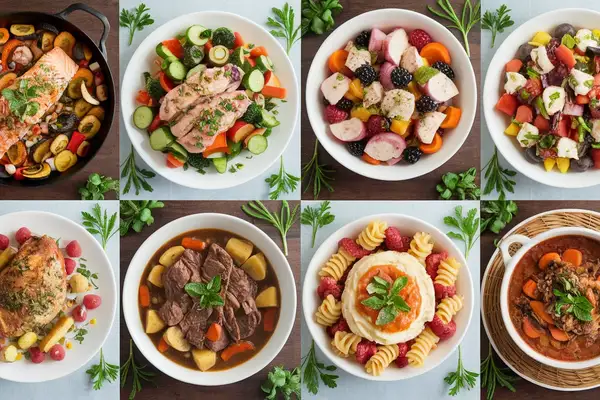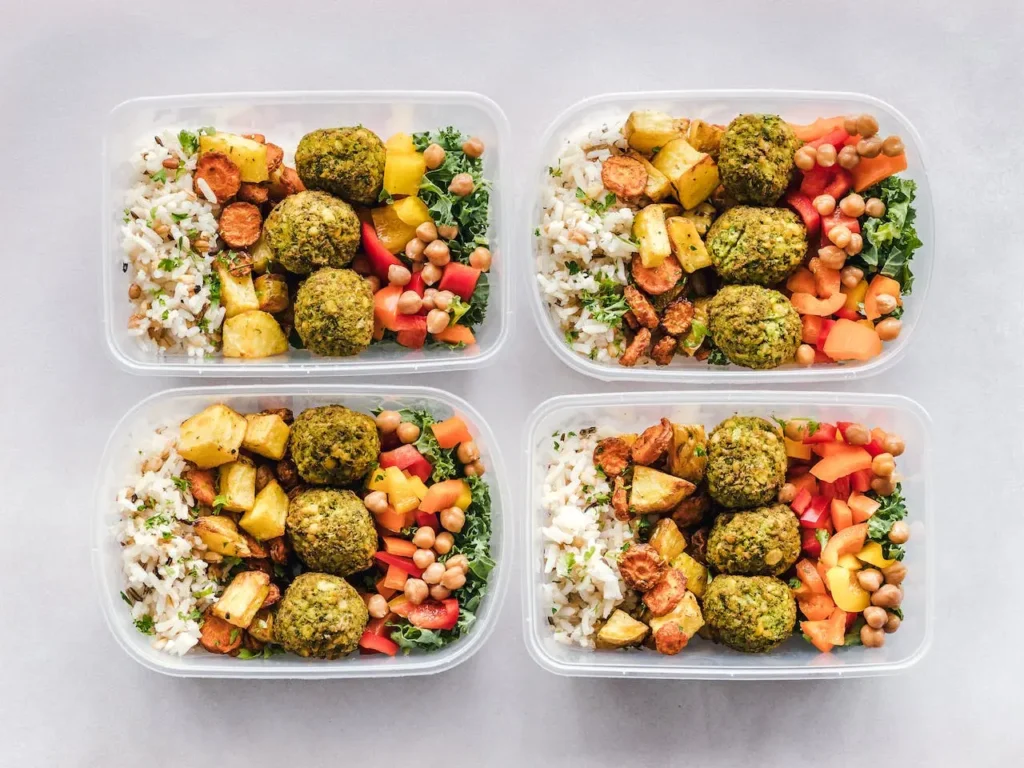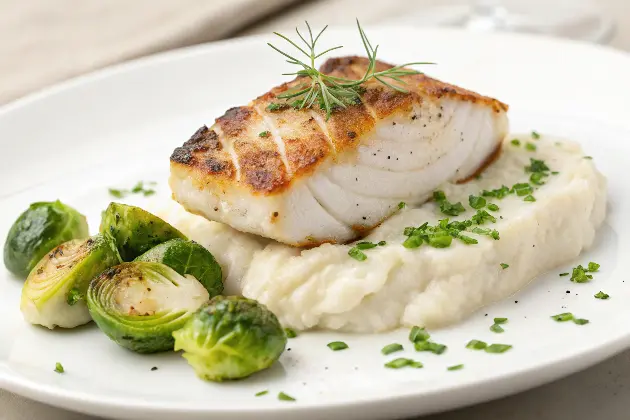Free 7 Day Type 2 Diabetes Diet Meal Plan
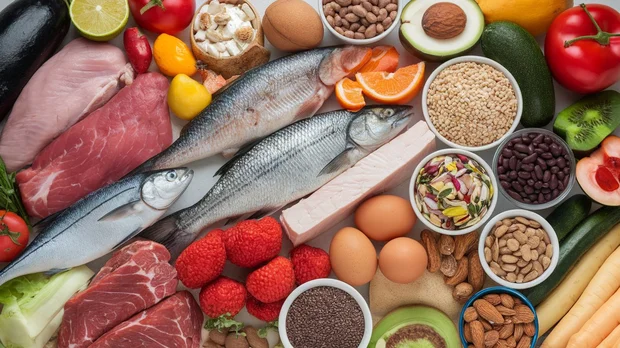
This post may contain affiliate links, meaning I may earn a commission if you make a purchase, at no extra cost to you. I only recommend products I trust. Thank you for your support.
Living with type 2 diabetes doesn’t mean you have to miss out on delicious and satisfying meals.
In fact, creating a well-balanced and tasty 7 day type 2 diabetes diet meal plan is easier than you might think.
With a focus on nutrient-dense, low glycemic foods, you can keep your blood sugar levels steady while enjoying flavorful and filling meals.
This guide will help you navigate your meal plan for type 2 diabetes, offering friendly type 2 diabetes recipes and tips that ensure you stay on track while enjoying a wide range of foods.
In this article, we’ll not only explore what type 2 diabetes is and how diet plays a role, but also present you with a balanced 7 day type 2 diabetes diet plan and a comprehensive type 2 diabetes food list that keeps your palate excited.
What is Type 2 Diabetes?
Before we jump into our type 2 diabetic meal plan, let’s quickly recap what type 2 diabetes is all about.
Type 2 diabetes is a chronic condition that affects the way your body processes glucose (sugar). In people with type 2 diabetes, the body either doesn’t produce enough insulin or becomes resistant to its effects.
This leads to high blood sugar levels, which can cause a range of health issues if not managed properly. The good news? Diet plays a crucial role in managing type 2 diabetes.
By making smart food choices, you can help control your blood sugar levels, maintain a healthy weight, and reduce the risk of diabetes related complications.
That’s where our 7 day type 2 diabetes diet meal plan comes in handy!
Type 2 Diabetes Diet Tips
Before we dive into the specifics of our type 2 diabetes meal plan, let’s cover some key principles of a type 2 diabetes diet:
- Focus on balanced meals: Include a mix of lean proteins, healthy fats, and complex carbohydrates in each meal.
- Control portion sizes: This helps manage calorie intake and blood sugar levels.
- Choose low glycemic index (GI) foods: These low GI foods cause a slower, more gradual rise in blood sugar.
- Increase fiber intake: High fiber foods help to slow down digestion and sugar absorption.
- Limit added sugars and refined carbs: These can cause rapid spikes in blood sugar.
- Stay hydrated: Drink plenty of water throughout the day.
- Eat regularly: Aim for 3 meals and 2-3 small snacks daily to keep blood sugar levels stable.
Now that we’ve got the basics down, let’s move on to our 7 day type 2 diabetes diet meal plan!
7 Day Type 2 Diabetes Diet Meal Plan (Type 2 Diabetes Menu)
This 7-day type 2 diabetes diet plan features balanced and easy type 2 diabetes recipes using low glycemic high fiber foods that help to stabilize blood sugar.
From hearty breakfasts to balanced dinners, the variety in this type 2 diabetes meal plan ensures that you receive essential nutrients without compromising taste.
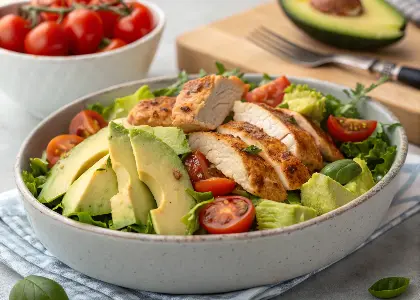
Day 1
Breakfast:
- Greek Yogurt with Berries and Chia Seeds: A light yet filling breakfast, this meal provides protein from yogurt and fiber from berries and chia seeds to keep your blood sugar stable. (1 cup plain Greek yogurt, ½ cup mixed berries, 1 tbsp chia seeds, sprinkle of cinnamon)
Lunch:
- Grilled Chicken Salad: A nutritious, low-carb salad packed with lean protein and healthy fats, ideal for controlling blood sugar. (4 oz grilled chicken breast, mixed greens, cucumbers, tomatoes, ¼ avocado, olive oil dressing)
Dinner:
- Baked Salmon with Roasted Vegetables: Salmon offers heart-healthy omega-3s, while roasted veggies provide fiber to keep blood sugar balanced. (5 oz baked salmon, 1 cup roasted Brussels sprouts and carrots, ½ cup quinoa)
- Side Salad: A simple salad adds extra fiber and nutrients. (1 cup mixed greens, 1 tablespoon olive oil, and lemon dressing)
Snacks:
- Celery Sticks with Almond Butter: A crunchy, satisfying snack with healthy fats to keep you energized between meals. (5 celery sticks, 2 tbsp almond butter)
- Pear and String Cheese: Combines fiber and protein for a balanced snack. (1 small pear, 1 piece string cheese)
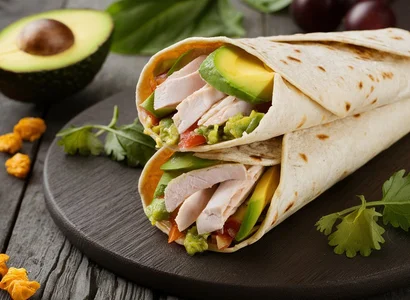
Day 2
Breakfast:
- Scrambled Eggs with Spinach and Feta: High-protein eggs paired with leafy greens help start your day with balanced energy. (2 scrambled eggs, ½ cup spinach, 1 tbsp crumbled feta)
- Whole Grain Toast and Grapefruit: Offers complex carbs and vitamin C. (1 slice whole grain toast, ½ grapefruit)
Lunch:
- Turkey and Avocado Lettuce Wraps: These low-carb lettuce wraps are loaded with healthy fats and protein, making them a great choice for lunch. (4 oz turkey breast, ½ avocado, cucumber slices, mustard, large lettuce leaves)
Dinner:
- Beef Stir-Fry with Cauliflower Rice: A flavorful lean beef stir-fry that skips the carbs by using cauliflower rice, perfect for keeping your blood sugar levels in check. (4 oz lean beef strips, bell peppers, onions, broccoli, 1 cup cauliflower rice)
- Roasted Brussels Sprouts and Sweet Potato: Provide fiber, vitamins, and a moderate amount of carbs. (1 cup roasted Brussels sprouts, 1 roasted small sweet potato)
Snacks:
- Mixed Nuts: A handful of nuts provides healthy fats and protein without spiking your blood sugar. (¼ cup unsalted almonds, walnuts, pistachios)
- Roasted Chickpeas: A crunchy, protein-rich snack with a fiber boost. (¼ cup roasted chickpeas)
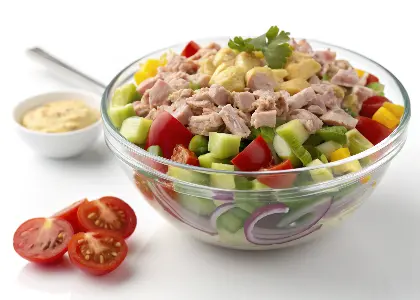
Day 3
Breakfast:
- Overnight Oats with Almonds and Blueberries: Fiber-rich oats and antioxidants from blueberries make for a balanced and filling breakfast. (½ cup rolled oats, ¾ cup almond milk, ¼ cup fresh blueberries, 1 tbsp slivered almonds)
Lunch:
- Tuna Nicoise Salad: This classic French salad is a lean source of protein with minimal saturated fat, helping to stabilize blood sugar levels. (4 oz canned tuna in water, 2 hard-boiled eggs halved, ½ cup steamed green beans, ½ cup cherry tomatoes, ¼ cup black olives, ¼ cup boiled and sliced red potatoes, 1 cup mixed greens, 1 tbsp olive oil with juice of ½ lemon)
Dinner:
- Chicken and Vegetable Skewers: Protein-packed chicken paired with colorful veggies on skewers for a low-carb, diabetes-friendly dinner. (5 oz grilled chicken, zucchini, bell peppers, red onion, ½ cup bulgur wheat)
- Steamed Broccoli: A low calorie vegetable rich in fiber and vitamins. (1 cup steamed broccoli)
Snacks:
- Carrot Sticks with Hummus: A crunchy, fiber-rich snack with protein-packed hummus to help control blood sugar levels. (8 carrot sticks, 2 tbsp hummus)
- Apple and Cheese: Combines fiber from the apple and protein from low-fat cheese. (1 small apple, 1 oz low-fat cheese)
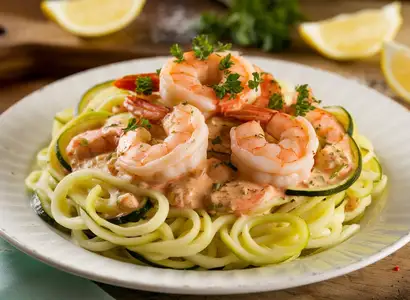
Day 4
Breakfast:
- Spinach Smoothie: A nutrient-packed smoothie with spinach, almond milk, protein powder, and banana for vitamins and a protein boost. (1 cup spinach, 1 cup unsweetened almond milk, 1 scoop protein powder, 1 small banana)
- Almond Butter Toast: Whole grain toast with almond butter for healthy fats and fiber. (1 slice whole grain toast, 1 tablespoon almond butter)
Lunch:
- Quinoa Salad with Chickpeas and Veggies: This high-fiber and protein-packed salad is great for stabilizing blood sugar. (½ cup quinoa, ¼ cup chickpeas, diced cucumbers, cherry tomatoes, lemon-tahini dressing)
Dinner:
- Shrimp Scampi Zoodles: A low carb and low glycemic twist on a classic dish, this meal is packed with protein and healthy fats, using zucchini noodles to keep it diabetes-friendly. (5 oz shrimp, 2 cups zucchini noodles, 2 tbsp olive oil, 2 cloves garlic minced, juice of ½ lemon, 1 tbsp parsley, pinch of red pepper flakes)
Snacks:
- Cucumber Slices with Cottage Cheese: A light and refreshing snack that provides a good source of protein. (10 cucumber slices, ½ cup cottage cheese)
- Pistachios: A handful adds healthy fats and protein. (¼ cup unsalted pistachios)

Day 5
Breakfast:
- Avocado Toast on Whole Grain Bread: Whole grains and healthy fats from avocado make for a balanced, satisfying breakfast. (½ mashed avocado, 1 slice whole grain toast, sprinkle of flax seeds)
Lunch:
- Grilled Shrimp Salad: Light yet satisfying, this salad combines high-protein shrimp with healthy fats and leafy greens. (5 oz grilled shrimp, arugula, cherry tomatoes, ¼ avocado, olive oil dressing)
Dinner:
- Turkey Stuffed Zucchini Boats: Lean ground turkey stuffed into zucchini halves, baked to perfection for a low-carb, high-protein meal that’s perfect for diabetes management. (4 oz ground turkey, 2 medium zucchini, ¼ cup diced tomatoes, 2 tbsp shredded mozzarella cheese, 1 tbsp Italian seasoning, 1 clove garlic minced)
- Chicken and Vegetable Soup: A light yet filling option with lean protein and high fiber vegetables, perfect for keeping blood sugar levels balanced. (4 oz shredded chicken breast, 1 cup diced carrots, 1 cup celery, ½ cup zucchini, 1 cup spinach, 4 cups low-sodium chicken broth, 1 tsp thyme, 1 clove garlic minced)
Snacks:
- Hard-Boiled Eggs: A quick, high-protein snack that keeps blood sugar stable. (2 hard-boiled eggs)
- Cherry Tomatoes and Cucumber with Ranch Dip: A low-calorie, hydrating snack with a light protein dip. (1 cup cherry tomatoes, 1 cup cucumber slices, 2 tablespoons light ranch dip)

Day 6
Breakfast:
- Chia Seed Pudding with Strawberries: Chia seeds are rich in fiber and help stabilize blood sugar levels, paired with low-sugar strawberries. (3 tbsp chia seeds soaked in almond milk, topped with ½ cup sliced strawberries)
Lunch:
- Lentil Soup: Hearty lentils packed with fiber and protein make this soup a filling and blood sugar-friendly lunch. (½ cup lentils, carrots, celery, onion, vegetable broth, 2 whole grain crackers)
Dinner:
- Baked Pork Tenderloin with Roasted Asparagus: Lean pork and fiber-rich asparagus make for a healthy, balanced dinner. (5 oz grilled pork tenderloin, 1 cup roasted asparagus, ½ cup sweet potato mash)
- Roasted Vegetables and Barley Pilaf: Provides fiber, vitamins, and minerals from the vegetables and whole grains. (2 cups roasted vegetables, ½ cup cooked barley)
Snacks:
- Apple Slices with Peanut Butter: A sweet and satisfying snack that won’t spike your blood sugar. (1 medium apple, 2 tbsp peanut butter)
- Edamame: High in protein and fiber, making for a filling, nutrient-dense snack. (½ cup edamame pods)
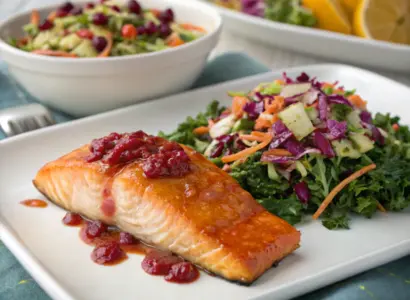
Day 7
Breakfast:
- Veggie Omelet: Packed with protein and vegetables, this omelet is a great way to start your day with steady energy. (2 eggs, ½ cup spinach, ¼ cup mushrooms, ¼ cup onions, cooked in olive oil)
Lunch:
- Tuna Salad with Mixed Greens: A protein-packed, light lunch that’s easy to prepare and helps manage blood sugar. (4 oz tuna, mixed greens, cucumber, olive oil vinaigrette)
- Whole Grain Pita: Adds whole grains to keep you satiated. (1 small whole grain pita, about 1 oz)
Dinner:
- Baked Salmon with Sautéed Kale: Salmon provides lean protein, while sautéed kale offers a healthy dose of fiber and vitamins. (5 oz baked cod, 1 cup sautéed kale with garlic)
- Roasted Zucchini and Quinoa Pilaf: A fiber rich, protein packed pilaf combining roasted zucchini with fluffy quinoa, making it a perfect diabetes friendly side or light meal. (1 cup cooked quinoa, 1 medium zucchini roasted, 1 tbsp olive oil, 1 clove garlic minced, 1 tbsp parsley, 1 tsp lemon zest)
Snacks:
- Greek Yogurt with Walnuts: High-protein yogurt with healthy fats from walnuts makes for a satisfying snack. (1 cup plain Greek yogurt, 2 tbsp walnuts)
- Bell Peppers with Guacamole: Low in calories but high in fiber and healthy fats. (1 cup sliced bell peppers, 2 tablespoons guacamole)
Type 2 Diabetes Diet Food List
To help you create your own meals and snacks, here’s a handy type 2 diabetes diet food list. These foods have a low glycemic index to help maintain steady blood sugar levels and are considered good choices for people managing type 2 diabetes:
Here is a list of foods that are known to help manage blood sugar levels, provide essential nutrients, and support overall health for individuals with type 2 diabetes.
1. Proteins
- Lean Meats: Skinless chicken, turkey, lean cuts of beef (sirloin, tenderloin), pork loin
- Fish and Seafood: Salmon, mackerel, tuna, cod, shrimp, sardines, trout (rich in omega-3 fatty acids)
- Plant-Based Proteins: Tofu, tempeh, edamame, lentils, chickpeas, black beans, kidney beans
- Eggs: Whole eggs, egg whites
- Low-Fat Dairy: Greek yogurt, cottage cheese, low-fat cheese, unsweetened almond milk
2. Non-Starchy Vegetables
- Leafy Greens: Spinach, kale, Swiss chard, arugula, collard greens
- Cruciferous Vegetables: Broccoli, cauliflower, Brussels sprouts, cabbage
- Other Vegetables: Zucchini, bell peppers, asparagus, green beans, eggplant, tomatoes, mushrooms, cucumbers, onions
- Squashes: Spaghetti squash, butternut squash, acorn squash
3. Fruits (in moderation)
- Berries: Strawberries, blueberries, raspberries, blackberries (high in fiber and antioxidants)
- Citrus Fruits: Oranges, grapefruits, lemons, limes
- Apples: Preferably with the skin on for added fiber
- Pears: Also best with the skin for fiber
- Stone Fruits: Peaches, plums, cherries
- Melons: Cantaloupe, watermelon (in moderation)
4. Whole Grains
- Whole Grains: Quinoa, brown rice, bulgur, barley, farro, millet
- Whole Grain Bread: 100% whole wheat bread, sprouted grain bread
- Whole Grain Pasta: Whole wheat pasta, chickpea pasta, lentil pasta
- Oats: Rolled oats, steel-cut oats (unsweetened)
- Cereals: High-fiber, low-sugar cereals
5. Healthy Fats
- Nuts and Seeds: Almonds, walnuts, chia seeds, flaxseeds, pumpkin seeds, sunflower seeds
- Nut Butters: Natural peanut butter, almond butter (without added sugars)
- Oils: Extra virgin olive oil, avocado oil, flaxseed oil
- Avocado: Fresh avocado, avocado oil
- Fatty Fish: Salmon, mackerel, sardines, tuna (rich in omega-3 fatty acids)
6. Dairy and Dairy Alternatives
- Low-Fat Dairy: Greek yogurt, cottage cheese, low-fat milk
- Non-Dairy Alternatives: Unsweetened almond milk, soy milk, coconut milk, cashew milk
7. Legumes and Beans
- Beans: Black beans, kidney beans, chickpeas, pinto beans, navy beans
- Lentils: Green lentils, red lentils, brown lentils
- Peas: Green peas, split peas
8. Spices and Herbs
- Herbs: Basil, oregano, thyme, rosemary, parsley, cilantro
- Spices: Cinnamon, turmeric, ginger, garlic, cumin, paprika, cayenne pepper
- Flavorings: Lemon juice, lime juice, vinegar, mustard, low-sodium soy sauce
9. Beverages
- Water: Still water, sparkling water
- Tea: Herbal tea, green tea, black tea (unsweetened)
- Coffee: Black coffee, with a splash of milk or cream (unsweetened)
- Milk Alternatives: Unsweetened almond milk, soy milk, coconut milk
10. Snacks
- Nuts: Small handful of almonds, walnuts, or mixed nuts
- Vegetable Sticks: Carrot sticks, cucumber slices, bell pepper strips with hummus
- Fruit with Nut Butter: Apple slices with almond butter, banana slices with peanut butter
- Greek Yogurt: Plain Greek yogurt with a sprinkle of cinnamon or a few berries
- Edamame: Steamed edamame pods
- Popcorn: Air-popped popcorn (unsalted, without added butter)
11. Condiments and Sauces
- Healthy Condiments: Salsa, hummus, guacamole, tahini, mustard
- Vinaigrettes: Olive oil and vinegar dressings, lemon juice, and olive oil
- Low-Sodium Options: Low-sodium soy sauce, low-sodium broth for cooking
12. Foods to Include Sparingly
- Starchy Vegetables: Sweet potatoes, yams, corn, peas (consume in small portions)
- Whole Fruits: Bananas, mangoes, grapes (in moderation due to higher sugar content)
- Dark Chocolate: Opt for dark chocolate (70% cocoa or higher) in small amounts
Type 2 Diabetes Foods to Avoid
While we’ve focused on what to eat, it’s equally important to know which foods to limit or avoid in a type 2 diabetes diet.
These foods can cause rapid spikes in blood sugar levels, contribute to insulin resistance, or provide little nutritional value.
Here is a list of foods to avoid with type 2 diabetes.
1. Sugary Foods
- Sugary Beverages: Soda, sweetened coffee drinks, energy drinks, fruit punches, sweetened iced teas
- Sweets and Desserts: Candy, cakes, cookies, pastries, doughnuts, ice cream, sugary cereals
- Artificial Sweeteners: High-fructose corn syrup, maltose, sucrose (opt for natural sweeteners like stevia in moderation)
2. Refined Carbohydrates
- White Bread: White sandwich bread, white rolls, bagels, English muffins
- Refined Grains: White rice, regular pasta, rice cakes
- Sugary Cereals: Cereals with added sugar or high-fructose corn syrup
- Crackers and Snacks: Saltine crackers, pretzels, chips, and other refined grain snacks
3. High-Fat and Fried Foods
- Fried Foods: French fries, fried chicken, fried fish, fried snacks (onion rings, mozzarella sticks)
- Fast Food: Burgers, pizza, fried chicken sandwiches, tacos with high-fat fillings
- High-Fat Meats: Fatty cuts of beef, pork belly, processed meats (bacon, sausage, hot dogs)
- Processed Meats: Ham, bologna, salami, pepperoni (often high in sodium and unhealthy fats)
4. Processed and Packaged Foods
- Packaged Snacks: Chips, cookies, crackers, sugary granola bars, snack cakes
- Instant Foods: Instant noodles, instant mashed potatoes, boxed macaroni and cheese
- Frozen Meals: Frozen pizzas, frozen dinners high in sodium and unhealthy fats
5. High-Sodium Foods
- Canned Soups and Vegetables: Canned soups, canned vegetables in brine (opt for low-sodium versions)
- Processed Meats: Deli meats, hot dogs, bacon, sausages (often high in sodium and preservatives)
- Salty Snacks: Potato chips, pretzels, salted nuts
- Sauces and Condiments: Soy sauce, teriyaki sauce, barbecue sauce, salad dressings (opt for low-sodium versions)
6. Full-Fat Dairy Products
- Full-Fat Milk: Whole milk, full-fat cream
- High-Fat Cheeses: Full-fat cheeses like cheddar, cream cheese, brie (opt for low-fat versions)
- Ice Cream and Custards: High-sugar ice creams, custards, and puddings
7. Sugary and Sweetened Dairy Products
- Flavored Yogurts: Yogurts with added sugar, fruit-flavored yogurts (opt for plain Greek yogurt)
- Sweetened Dairy Beverages: Chocolate milk, sweetened coffee creamers
8. High-Glycemic Fruits and Vegetables
- Certain Fruits: Canned fruits in syrup, fruit juices (opt for whole, fresh fruits in moderation)
- Starchy Vegetables: White potatoes, corn, pumpkin (consume in moderation due to high starch content)
9. Alcohol
- Sugary Cocktails: Margaritas, daiquiris, piña coladas, sweetened mixed drinks
- Beer: Regular beer (opt for light beer or limit intake)
- Liquor with Sugary Mixers: Spirits mixed with soda, tonic, or sweetened juices
10. Baked Goods and Pastries
- Breads and Muffins: Croissants, white bread, pastries, doughnuts, muffins (opt for whole-grain versions)
- Desserts: Cakes, cookies, brownies, pies
11. High-Fat, Processed Snacks
- Chips: Potato chips, corn chips, tortilla chips, cheese puffs
- Snack Mixes: Trail mixes with candy or high sugar content, chocolate-covered snacks
12. Trans Fats
- Margarine and Shortening: Margarine sticks, shortening, hydrogenated oils
- Packaged Baked Goods: Store-bought cookies, cakes, crackers, and pastries with trans fats
- Fried Fast Foods: Deep-fried fast food items containing trans fats
13. Artificial Sweeteners and Additives
- Artificial Sweeteners: Aspartame, saccharin (limit use, opt for natural sweeteners in moderation)
- Additives: High-fructose corn syrup, artificial colors, and flavors
14. High-Calorie, Low-Nutrient Foods
- High-Calorie Snacks: Candy bars, chocolate bars, ice cream cones
- High-Fat Sauces and Dressings: Cream-based sauces, high-fat salad dressings, cheese sauces
Eating Schedule for Type 2 Diabetes
You might be wondering, “What is the eating schedule for type 2 diabetes?” Great question! While there’s no one-size-fits-all answer, studies recommend the following schedule:
- Eat breakfast within 1-2 hours of waking up: This helps regulate blood sugar levels after the overnight fast.
- Have a small snack mid-morning: This can help maintain steady blood sugar levels between breakfast and lunch.
- Eat lunch about 4-5 hours after breakfast: This timing helps keep your metabolism active and blood sugar levels stable.
- Have an afternoon snack: This can prevent overeating at dinner and help manage blood sugar levels.
- Eat dinner at least 2-3 hours before bedtime: This allows time for digestion before sleep.
- Consider a small bedtime snack if needed: If your blood sugar tends to drop overnight, a small protein-rich snack before bed might help.
Remember, the key is to space your meals and snacks evenly throughout the day to help maintain stable blood sugar levels.
Conclusion
There you have it, a comprehensive type 2 diabetes diet plan, along with lots of helpful information to guide you on your journey to better health.
Remember, managing type 2 diabetes is about more than just avoiding certain foods. It’s about nourishing your body with a variety of nutritious foods, maintaining a balanced diet, and finding an eating pattern that works for you.
While this type 2 diabetes meal plan provides a great starting point, it’s important to personalize your approach.
Everyone’s body is different, and what works perfectly for one person might need some tweaking for another.
Don’t be afraid to experiment (while monitoring your blood sugar, of course) to find the meals and eating schedule that make you feel your best.
Living with type 2 diabetes doesn’t mean you can’t enjoy delicious, satisfying meals. With a little planning and creativity, you can create the best meal plan for type 2 diabetes that not only helps manage your blood sugar but also brings you joy.
Remember to stay in touch with your healthcare team, including your doctor and a registered dietitian if possible. They can provide personalized advice and help you adjust your type 2 diabetic meal plan as needed.
- How to reverse prediabetes in 3 months
- What is Zepbound?
- 7-day meal plan for gestational diabetes
- 2 week no sugar diet meal plan
- 7-day meal plan for prediabetes
- 7-day diabetic meal plan
- Mounjaro for type 2 diabetes
- 7 day Ozempic diet plan
- Foods to avoid while on Saxenda
- 7 day meal plan for low potassium diet
- 7-day diet to lower triglycerides
- 7-day protein diet plan for weight loss
- Anti-inflammatory diet meal plan
- 21-day Fix meal plan for beginners
- Brain health diet plan
- Healthy Mediterranean diet meals
- Iron rich diet for anemia
FAQs
What is the best meal for type 2 diabetes?
The best meal for type 2 diabetes includes lean protein, non-starchy high fiber vegetables, and a small portion of complex carbohydrates.
How is type 2 diabetes related to diet?
Consuming foods that help maintain stable blood sugar levels helps prevent blood sugar spikes, maintain a healthy weight, and reduce the risk of diabetes-related complications.
Can I live a normal life with type 2 diabetes?
Yes, many people with type 2 diabetes live full, active lives. By managing your diet for type 2 diabetes, staying physically active, and monitoring your blood sugar levels, you can effectively manage the condition.
Are bananas ok for diabetics?
Bananas can be part of a balanced diet for people with type 2 diabetes, but it’s important to monitor portion sizes as bananas are higher in carbohydrates.
A small banana (about 15 grams of carbs) is a better option for controlling blood sugar levels.
How many grams of sugar per meal for type 2 diabetes?
The general recommendation for people with type 2 diabetes is to limit added sugars as much as possible.
Natural sugars from whole fruits and vegetables such as stevia, monk fruit extract, and coconut sugar are generally fine in moderation as part of a balanced meal.
How many carbs per meal with type 2 diabetes?
For most people with type 2 diabetes, the recommended carbohydrate intake per meal is between 45-60 grams but it’s better to consult with a dietitian or healthcare provider to determine your ideal carb intake.
Disclaimer: This type 2 diabetes diet plan is for informational purposes only and should not be considered medical advice.
Always consult with your healthcare provider or a registered dietitian before making significant changes to your diet, especially if you have diabetes or any other health condition.
